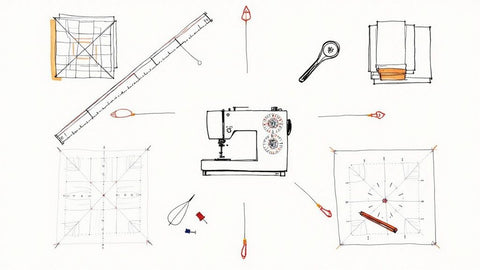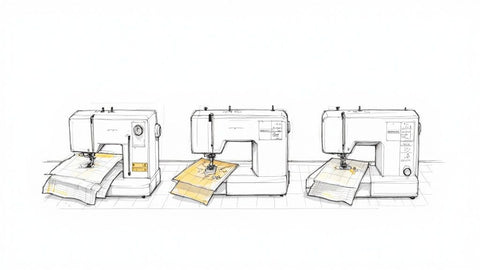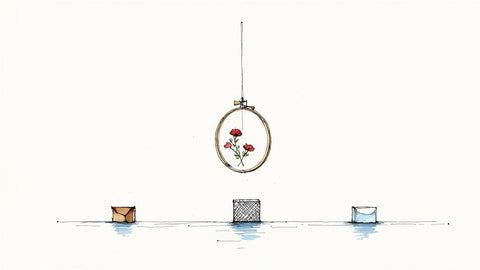Jumping into your first quilting project is such an exciting moment! It’s the first step into a really special world of creativity and tradition. Don’t worry, it's not as complicated as it looks. The essential quilting supplies for beginners really just boil down to five key areas: a solid sewing machine, good cutting tools, quality fabric, a few key "notions," and some smart storage solutions. That’s it! It’s just a matter of gathering these foundational pieces, and you're ready to go.
Starting Your Quilting Journey With Confidence
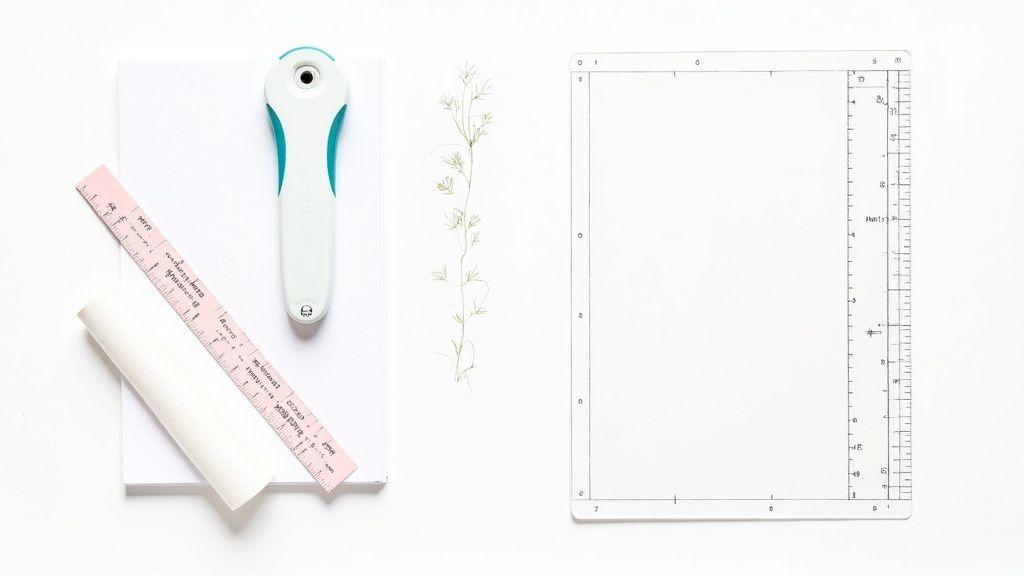
Welcome to the wonderful world of quilting! It’s a craft that magically turns simple pieces of fabric into beautiful, functional art. I know that looking at all the tools and gadgets for the first time can feel a little overwhelming, but think of this guide as your creative roadmap. It’s here to cut through the noise and give you clear, actionable advice on creating your first sewing machine designs.
There's nothing quite like the feeling of taking a pile of fabric scraps and watching them become a finished quilt. It’s a hobby that has captivated people for centuries, and it’s never been easier to get started. You’re actually joining a huge, growing community—the global quilt market was valued at around USD 5.32 billion and is only getting bigger. It’s amazing to see how many people are picking up this craft!
What to Expect in This Guide
I’ve broken down everything you’ll need into easy-to-digest categories, so you can gather your supplies without feeling lost. We'll walk through the must-have tools that will set you up for success right from your very first stitch.
Here’s a quick peek at what we'll cover:
- Quilting Machines: This is the heart of your sewing space. We’ll look at features that are perfect for someone just starting out.
- Cutting Tools: Meet the non-negotiable trio for getting those perfectly shaped fabric pieces every single time.
- Fabric Selection: We'll dive into why cotton is king and how to pick out colors that will make your quilt pop.
- Essential Notions: These are the small but mighty items that make the whole process so much smoother.
Here at bsewinn.com, we’re committed to empowering crafters. Our custom sewing machine designs are made with beginners in mind, and we offer extensive support through our vast collection of online classes and training resources to guide you. Before we get into the nitty-gritty, check out our simple overview on the 4 easy steps to start quilting. With the right tools and a little guidance, you’re all set to start making something beautiful.
Choosing Your First Quilting Machine
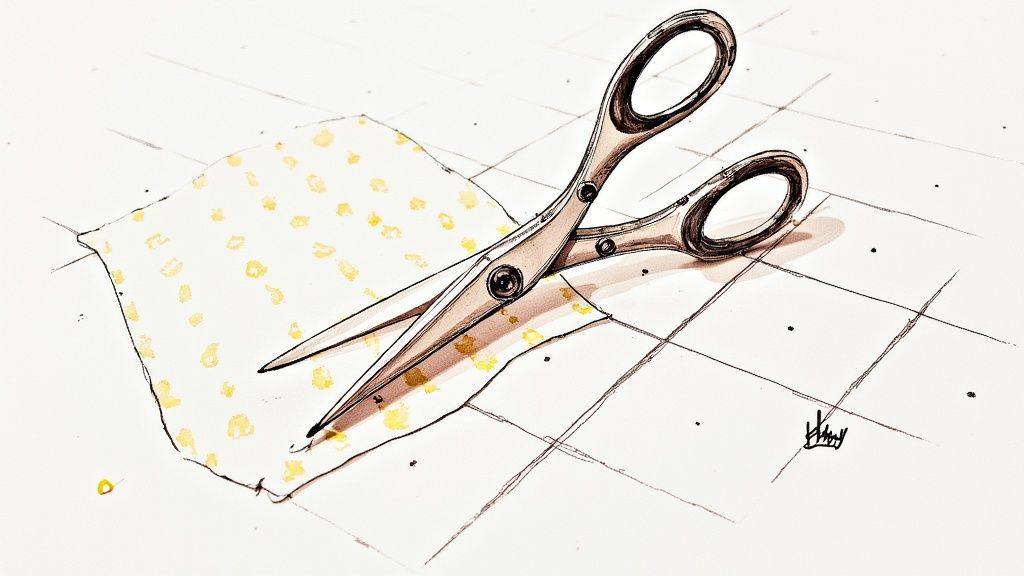
Your sewing machine is the absolute heart of your quilting space. I like to think of it as my creative partner—the right one makes every project feel like a dream, while the wrong one can just lead to a whole lot of frustration. When you first start looking, it's so easy to get blinded by machines boasting hundreds of decorative stitches and features you'll probably never touch.
But here’s a little secret I've learned over the years: for your first quilting machine, simplicity and reliability are your best friends. The single most important feature you need is a high-quality, consistent straight stitch. Seriously. That one stitch will do 95% of the work when you're piecing your quilt blocks together.
Core Features That Truly Matter
Let's push aside the bells and whistles for a minute and focus on what will actually make your quilting life easier. These are the non-negotiables, the foundational features of a great quilting machine.
- A Walking Foot: This special presser foot is an absolute game-changer for quilters. It has its own set of feed dogs on the bottom that grip the top layers of your quilt "sandwich" (the quilt top, batting, and backing). This ensures all three layers move together at the same speed, which prevents them from shifting and bunching up. The result? Beautiful, pucker-free quilting lines. It’s a must-have.
- Generous Throat Space: This is simply the distance between the needle and the body of the machine. The more space you have, the easier it is to maneuver your quilt, especially as you start tackling bigger projects. A standard machine is fine for piecing, but having that extra room is a huge advantage when it's time for the actual quilting.
Just these two features alone will dramatically improve your results and make the whole process so much more enjoyable. They are key items on any list of essential quilting supplies for beginners.
"A reliable machine that grows with you is the best investment a new quilter can make. Focus on a solid stitch, a walking foot, and room to work—these fundamentals will empower you to create with confidence from day one."
Understanding Quilting Techniques
As you browse machines, you'll definitely come across terms like "free-motion quilting." Don't let the jargon scare you! All it means is that you lower the machine's feed dogs (the little teeth that pull the fabric through) and guide the fabric freely by hand to "draw" your own designs with thread. It's incredibly fun and creative.
To do this, you just need a machine that lets you drop the feed dogs and attach a darning or free-motion foot. This feature opens up a whole new world of artistic possibilities way beyond simple straight lines.
At bsewinn.com, we are committed to empowering crafters through our custom sewing machine designs. We understand that getting to know a new machine is a journey, which is why we provide extensive support via our online classes, training, and a wealth of resources. Our goal isn't just to sell you a machine, but to help you kickstart a fulfilling creative adventure, building tangible skills you can use to replicate beautiful designs.
Mastering the Essential Cutting Tools
Precision is the secret ingredient behind every stunning quilt. It all starts with making accurate, consistent cuts long before your fabric ever sees a sewing machine.
While you might be tempted to just grab any old pair of scissors, the quilting world relies on a non-negotiable trio of tools for truly professional results. Think of these as the chef's knife and cutting board of your new craft. This powerful combination—the rotary cutter, self-healing mat, and acrylic ruler—is often called the 'holy trinity' of quilting for a reason.
Together, they make sure every single piece is cut perfectly. This makes the sewing process dramatically easier and way more fun. Trust me, getting comfortable with these tools is one of the most important first steps you'll take.
The growing popularity of quilting has led to a big jump in sales for starter kits and tools. In fact, home crafting markets have seen growth of over 5% year after year, mostly driven by beginners just like you investing in these essential supplies.
The Rotary Cutter
Imagine a pizza cutter, but for fabric. That's a rotary cutter! Its super-sharp, rolling blade lets you make long, straight cuts with incredible speed and accuracy—something scissors just can't compete with.
For beginners, a 45mm rotary cutter is the perfect all-purpose size. It’s beefy enough to slice through long strips of fabric but still nimble enough for trimming up smaller pieces. When you're shopping, always look for safety features, like a blade guard that retracts automatically or locks securely in place. Learning to use this tool safely is a skill you'll use forever.

As you can see, the initial investment in good tools is pretty small, but the impact they have on your final quilt is huge.
Self-Healing Mat and Acrylic Rulers
Your rotary cutter is only as good as the surface you cut on. A self-healing cutting mat is non-negotiable; it protects your table from getting sliced up and, just as importantly, keeps your rotary blade from dulling instantly. These incredible mats are designed to absorb the cuts, almost magically "healing" over the slice marks.
My advice? Go big. Investing in a larger mat, something like 24x36 inches, is a smart move. It gives you plenty of room to cut long strips of fabric right off the bolt without having to constantly shift everything around.
The final piece of the puzzle is your acrylic ruler. These are your guides for absolute precision, with clear markings that let you measure and cut with total confidence.
A quilter's ruler does more than just measure; it provides a straight, stable edge for your rotary cutter to glide against. This partnership between ruler and cutter is what guarantees perfectly identical shapes for your quilt blocks, every single time.
A great starter size is a 6x24 inch ruler. It's ideal for cutting those initial strips from your fabric. The accuracy these tools provide is a total game-changer, and you can learn even more about the benefits of rotary cutting in our detailed guide.
To make it even easier, here's a quick checklist of the cutting tools you'll want to have on hand before you start your first project.
Beginner's Quilting Cutting Tools Checklist
| Tool | Primary Function | Beginner-Friendly Feature |
|---|---|---|
| Rotary Cutter | Slicing fabric with a rolling blade | 45mm size for versatility |
| Self-Healing Mat | Protecting surfaces and preserving the blade | 24x36 inch size for ample workspace |
| Acrylic Ruler | Guiding the cutter for precise measurements | 6x24 inch size for cutting long strips |
Having this trio ready to go will set you up for success and make your first quilting experience a whole lot smoother.
Selecting Fabric for Your First Quilt
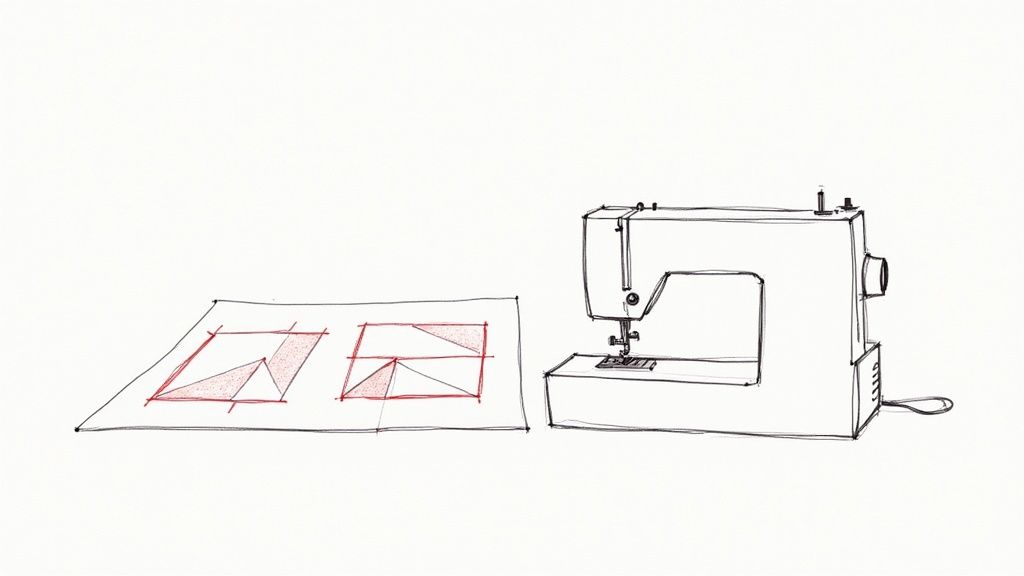
This is where the magic really happens. Fabric is the heart and soul of your quilt, the part that gives it personality. Walking into a fabric shop for the first time is a feeling I'll never forget—it’s both thrilling and completely overwhelming. Don't worry, picking the right fabric is way easier than it looks. The goal is to find materials that aren't just pretty, but are a dream to sew with.
For your very first quilt, there's one hands-down winner: 100% quilting cotton. Now, this isn't the same flimsy cotton you find in a t-shirt. It's a high-quality, medium-weight fabric with a tight, even weave that acts like a sturdy, reliable canvas. It holds its shape beautifully when you cut it, presses to a crisp finish, and glides right through your machine. It’s the perfect starting point.
The quilting fabric industry is huge, estimated at around $5 billion and still growing. Cotton and flannel are quilter-favorites for a reason—they're soft, breathable, and so easy to handle, which makes learning the ropes a whole lot smoother.
Decoding Fabric Terminology
As you start shopping, you’ll see words like "fat quarters" and "jelly rolls" tossed around. Think of these as your quilting cheat codes. They’re pre-cut bundles of coordinating fabrics that save you a ton of time and take the anxiety out of matching colors.
- Charm Packs: These are little stacks of 5-inch squares. They are perfect for patchwork projects and mean you can get straight to sewing without much cutting.
- Jelly Rolls: These are long, 2.5-inch wide strips rolled up to look like, well, a jelly roll! They’re fantastic for any pattern that uses strip piecing.
- Fat Quarters: A fat quarter is a quarter-yard of fabric, but it's cut to be wider and more squarish (around 18x22 inches) than a traditional long quarter-yard. This shape is super versatile and gives you more flexibility for cutting different shapes.
Starting with a pre-cut bundle is a game-changer. The designers have already done the hard work of creating a beautiful color palette, so you’re guaranteed a gorgeous, professional-looking result right from the start. Of course, the type of fiber matters too; you can explore a complete guide to cotton and polyester fabrics to see how different materials behave.
Preparing Your Fabric for Success
Before you even think about making your first cut, there are two crucial things to get right: understanding fabric grain and the importance of pre-washing. Fabric grain is just the direction of the threads. If you cut along the grain, your pieces will be stable and won't stretch out of shape as you work with them.
The single most important habit a new quilter can develop is preparing fabric correctly. Pre-washing your fabric prevents shrinkage and color bleeding after your quilt is finished, protecting all your hard work.
Trust me on this—pre-washing is a step you can't skip. Just toss your fabrics in the wash with a gentle detergent and dry them before you begin. This gets all the shrinking and potential color bleeding out of the way before you sew everything together, not after you’ve poured hours into your masterpiece. It's a little extra time upfront that ensures your quilt will be something you can love and use for years to come.
Understanding Your Must-Have Quilting Notions
If your sewing machine is the engine and your fabric is the body of the car, then quilting notions are all those little essential parts under the hood that make the whole thing actually run. We’re talking about the unsung heroes of your sewing room—the threads, the pins, the markers. These are the quilting supplies that can turn a frustrating first project into something you actually enjoy.
They might seem small, but they make a huge difference in how accurate and efficient you are. Think of your notions as your own personal pit crew. Each little tool has a specific job, all designed to support you and make sure every piece of your quilt comes together just right. Getting a small collection of these key items will set you up for success.
Thread: The Essential Connector
The very first notion on any quilter's list has to be good quality thread. Trust me on this one. Cheap thread is a quilter’s nightmare—it’s brittle, creates a shocking amount of lint inside your machine, and has a nasty habit of snapping at the worst possible moment.
For piecing together your quilt blocks, the gold standard is a 50-weight 100% cotton thread. This thread is strong enough to create seams that last, but it's also fine enough that it won't add any extra bulk to your seams. When you’re just starting, grab a neutral color like a light grey, cream, or beige. It’s incredibly versatile and will blend in with almost any fabric you choose, which means you can use one spool for a whole project without constantly stopping to re-thread your machine.
Pins and Clips: Your Third and Fourth Hands
Keeping your layers of fabric perfectly lined up is non-negotiable for accurate sewing. This is where pins and clips come in, acting like an extra set of hands to hold everything right where it needs to be.
- Straight Pins: Look for sharp, fine pins with glass heads. The glass is a lifesaver because it won't melt if you accidentally hit it with your iron (and you will!). They’re perfect for securing seams and matching up those tricky points on your quilt blocks.
- Quilting Clips: These look a bit like tiny binder clips and are amazing for holding your binding in place while you sew. They’re also great for securing the thick layers of your quilt "sandwich" (the top, batting, and backing). They're way easier to manage than pins when you're dealing with that much bulk and they don't leave holes behind.
It's a classic beginner mistake to think you can skimp on pins. Using them generously is the real secret to preventing your fabric from shifting while you sew—it’s how you get those perfectly matched seams you admire in other people's quilts.
Marking Tools and Seam Rippers
Let’s be real: mistakes are just part of the learning process. That’s why a good seam ripper will quickly become your best friend. A sharp, comfortable one makes fixing those little slip-ups quick and painless. You’ll also need a reliable way to draw guidelines on your fabric. A water-soluble or heat-erasable fabric pen is a fantastic choice; the marks vanish completely with a spritz of water or a quick touch of the iron.
These small but mighty notions are the foundation of a great sewing kit. For a deeper dive into other handy gadgets, you should check out our guide on the top sewing tools for beginners. Having these essentials ready to go means you're prepared for whatever your next project throws at you.
Your First Project: A Tangible How-To Example
Okay, you've unboxed all your beautiful new quilting tools. Now for the fun part—actually using them! This is the moment where everything clicks, where you go from just having a pile of supplies to seeing how they all work together to make something amazing.
Let's dive right in with a real-world example you can replicate. We're going to make a simple nine-patch block. It's a classic for a reason and the perfect project to get your feet wet without feeling like you're in over your head. This little block is where you’ll really see how your quilting supplies for beginners become a cohesive system.
Creating Your First Block
First up, the cutting. Grab your acrylic ruler, lay your fabric on the self-healing mat, and let that rotary cutter do its thing. You’ll be slicing your fabric into perfectly identical squares. Right away, you'll see why those cutting tools are so critical—getting this part precise makes the sewing a thousand times easier.
Now, take those perfect squares over to your sewing machine. Use your pins or clips to hold the pieces snugly together and stitch them up with a consistent quarter-inch seam. This is where you'll see your machine, armed with a good needle and thread, turn flat fabric into a real, three-dimensional quilt block. Your marking pen can help draw a few guidelines, and don't worry—that seam ripper is patiently waiting on the sidelines, just in case. No judgment here!
This isn't just a practice run; it's about building your confidence. With every step, you'll get a feel for what each tool does, and you'll understand firsthand why every single item in your kit is essential for getting those beautiful, sharp points you're dreaming of.
Here at bsewinn.com, we are huge believers in learning by doing. Our custom sewing machines are designed to be intuitive, and we empower crafters through our extensive library of online classes and training resources. These tutorials provide the support you need to replicate this project and other sewing machine designs, helping you nail foundational skills with skill and excitement.
Got Questions About Beginner Quilting Supplies?
When you’re just starting out, the world of quilting supplies can feel a little overwhelming. I get it! Let's tackle some of the most common questions I hear from new quilters so you can walk into that quilt shop with confidence.
How Much Should I Budget for Supplies?
This is always the first question, and it's a smart one. Not counting your sewing machine, a good starting budget for the essentials—the really quality stuff that won’t let you down—is anywhere from $150 to $300. You can definitely save money on fabrics by hunting for sales or digging through remnant bins (which is half the fun!), but I always tell beginners to invest in a great rotary cutter and mat right from the get-go. Trust me, it will save you so much frustration later.
Can I Just Use Scissors Instead of a Rotary Cutter?
Well, you can, but I wouldn't recommend it. A rotary cutter, a self-healing mat, and a long acrylic ruler are like the holy trinity of quilting. This trio is the secret to getting unmatched accuracy and speed. When every piece of fabric is cut perfectly and identically, your quilt blocks come together with those crisp, sharp points that make a quilt look so professional.
What Kind of Thread Should I Use?
For piecing your quilt top together, you can't go wrong with a 50-weight, 100% cotton thread. It’s the workhorse of the quilting world. I suggest starting with a neutral color like a soft grey or a creamy off-white. This thread is strong enough to hold your quilt together for years but fine enough that it won't add extra bulk to your seams.
Help! How Do I Choose Fabrics That Go Together?
Choosing coordinating fabrics feels like the biggest hurdle for so many new quilters, but there's a super simple trick: start with a pre-cut fabric bundle! Look for charm packs (5" squares), jelly rolls (2.5" strips), or layer cakes (10" squares). The fabric designers have already done all the beautiful color-matching work for you, guaranteeing a gorgeous result every time. It's like having a personal stylist for your quilt!
Ready to turn that pile of fabric into a masterpiece? B-Sew Inn has the machines, tools, and friendly support to help you every step of the way. Come explore our collection and let's start your quilting adventure today - powered by freeform

